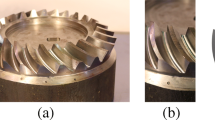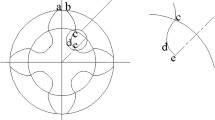Abstract
Workpieces with a globoid shape have been used extensively in industry. However, its hourglass shape increases machining difficulty and requires exact accuracy during manufacturing. The issues could be remedied using a different manufacturing procedure to minimize machining difficulties. As a result, our research developed a way to reduce machining challenges. The novelty of the study is the general mathematical model for machining the globoid screw rotor surface. The machining process on both flank surfaces of the workpiece is conducted simultaneously using a disk-type cutting tool. Analytical and virtual cutting simulations on globoid screw rotor surface machining are investigated. The machine setting and the coordinate system are proposed. A mathematical model for the surface of the tool and workpiece is presented. The generation of the workpiece surface on the offered machine is investigated. The machining process simulation of the globoid screw rotor surface by the disk-type cutting tool is performed. The numerical solution of cutting points and the normal deviation of the globoid rotor surface are solved. Sensitivity analysis, additional movements, cutting tool assembly error, and the numerical solution for machine-axis settings using the Levenberg–Marquardt algorithm are conducted. Virtual cutting simulation is presented using VERICUT. Verification of mathematical modeling is performed. The hourglass worm and the roller-gear cam are taken as numerical examples. Results from the machining examples are presented to verify the advantages of manufacturing the globoid rotor surfaces in the proposed method.


















Similar content being viewed by others
Data Availability
All data generated or analyzed during this study are included in the manuscript.
References
Andrianto M, Wu YR, Arifin A (2022) A novel manufacturing method for double-enveloping worms using a whirl-machining process. Mech Mach Theory 179:105099. https://doi.org/10.1016/j.mechmachtheory.2022.105099
Radzevich SP (2018) Theory of gearing kinematics, geometry, and synthesis, second edition: revised and expanded edn. Taylor & Francis Group, LLC
Zhou W, Tang J, Chen H, Shao W, Zhao B (2019) Modeling of tooth surface topography in continuous generating grinding based on measured topography of grinding worm. Mech Mach Theory 131:189–203. https://doi.org/10.1016/j.mechmachtheory.2018.10.001
Wang Y, Chen Y, Zhou G, Lv Q, Zhang Z, Tang W, Liu Y (2016) Roughness model for tooth surfaces of spiral bevel gears under grinding. Mech Mach Theory 104:17–30. https://doi.org/10.1016/j.mechmachtheory.2016.05.016
Yang YC, Wu YR, Tsai TM (2022) An analytical method to control and predict grinding textures on modified gear tooth flanks in CNC generating gear grinding. Mech Mach Theory 177:105023. https://doi.org/10.1016/j.mechmachtheory.2022.105023
Simon VV (2023) Grinding of hypoid gears by applying generating and Waguri motions. Mech Mach Theory 179:105100. https://doi.org/10.1016/j.mechmachtheory.2022.105100
Beaucamp A, Kirsch B, Zhu W (2022) Advances in grinding tools and abrasives. CIRP Ann 71:623–646. https://doi.org/10.1016/j.cirp.2022.05.003
Nair R, Paul L (2022) Advancements in abrasive electrical discharge grinding (AEDG): a review. Mater Today 72:2897–2903. https://doi.org/10.1016/j.matpr.2022.07.413
Wei L, Liang JW, Gui L, Bo W, Alsoufi MS, Elsheikh A, Ibrahim AMM (2022) Analysis of large edge breakage of WC-Co cemented carbide tool blades emerging in precision grinding process. J Mater Res Technol 19:3916–3929. https://doi.org/10.1016/j.jmrt.2022.06.103
Pervez MR, Ahamed MH, Ahmed MA, Takrim SM, Dario P (2022) Autonomous grinding algorithms with future prospect towards SMART manufacturing: a comparative survey. J Manuf Syst 62:164–185. https://doi.org/10.1016/j.jmsy.2021.11.009
Denkena B, Schindler A, Woiwode S (2016) Calculation method of the contact area in flank machining for continuous generating grinding. Appl Math Model 40:7138–7146. https://doi.org/10.1016/j.apm.2016.02.030
Santander JLG (2015) Analytic solution for maximum temperature during cut in and cut out in surface dry grinding. Appl Math Model 40:2356–2367. https://doi.org/10.1016/j.apm.2015.09.031
Shiau TN, Huang KH, Wang FC, Chen KH, Kuo CP (2010) Dynamic response of a rotating ball screw subject to a moving regenerative force in grinding. Appl Math Model 34:1721–1731. https://doi.org/10.1016/j.apm.2009.09.018
Stepien P (2009) A probabilistic model of the grinding process. Appl Math Model 33:3863–3884. https://doi.org/10.1016/j.apm.2009.01.005
Skuratov DL, Ratis YL, Selezneva IA, Perez J, Cordoba PF, Urchueguıa JF (2007) Mathematical modelling and analytical solution for workpiece temperature in grinding. Appl Math Model 31:1039–1047. https://doi.org/10.1016/j.apm.2006.03.023
Wu YR, Hsu WH (2014) A general mathematical model for continuous generating machining of screw rotors with worm-shaped tools. Appl Math Model 38:28–37. https://doi.org/10.1016/j.apm.2013.05.056
Bartkowska D, Bartkowski R, Swadźba DP, Miklaszewski A (2018) Microstructure, chemical composition, wear, and corrosion resistance of FeB–Fe2B–Fe3B surface layers produced on Vanadis-6 steel using CO2 laser. Int J Adv Manuf Technol 95:1763–1776. https://doi.org/10.1007/s00170-017-1304-z
Bartkowski D, Bartkowska A, Popławski M, Przestacki D (2020) Microstructure, microhardness, corrosion and wear resistance of B, Si and B-Si coatings produced on C45 steel using laser processing. Metals 10:792. https://doi.org/10.3390/met10060792
Bendoumia A, Makuchb N, Chegrounea R, Kulkab M, Keddama M, Dziarskib P, Przestacki D (2020) The effect of temperature distribution and cooling rate on microstructure and microhardness of laser re-melted and laser-borided carbon steels with various carbon concentrations. Surf Coat Technol 387:125541. https://doi.org/10.1016/j.surfcoat.2020.125541
Sika R, Rogalewicz M, Popielarski P, Czarnecka-Komorowska D, Przestacki D, Gawdzinska K, Szymanski P (2020) Decision support system in the field of defects assessment in the metal matrix composites castings. Materials 13:3552. https://doi.org/10.3390/ma13163552
Kukliński M, Bartkowska A, Przestacki D (2018) Microstructure and selected properties of Monel 400 alloy after laser heat treatment and laser boriding using diode laser. Int J Adv Manuf Technol 98:3005–3017. https://doi.org/10.1007/s00170-018-2343-9
Zhou R, Zhao N, Li W, Li R, Guo G, Guo H (2019) A grinding method of face gear mating with a conical spur involute pinion. Mech Mach Theory 141:226–244. https://doi.org/10.1016/j.mechmachtheory.2019.07.013
Guo H, Zhang S, Wu T, Zhao N (2021) An approximate design method of grinding worm with variable meshing angle and grinding experiments of face gear. Mech Mach Theory 166:104461. https://doi.org/10.1016/j.mechmachtheory.2021.104461
Wang Y, Chu X, Huang Y, Su G, Liu D (2019) Surface residual stress distribution for face gear under grinding with a long-radius disk wheel. Int J Mech Sci 159:260–266. https://doi.org/10.1016/j.ijmecsci.2019.06.004
Wang Y, Liu Y, Chu X, He Y, Zhang W (2017) Calculation model for surface roughness of face gears by disc wheel grinding. Int J Mach Tools Manuf 123:76–88. https://doi.org/10.1016/j.ijmachtools.2017.08.002
Litvin FL, Fuentes A (2004) Gear Geometry and Applied Theory, 2nd edn. Cambridge University Press, Cambridge, UK
Shih YP, Sun ZH, Wu FC (2018) A disk tool cutting method for bevel gear manufacture on a five-axis machine. Int J Adv Manuf Technol 94:855–865. https://doi.org/10.1007/s00170-017-0918-5
Pham TT, Ko SL (2010) A manufacturing model of an end mill using a five-axis CNC grinding machine. Int J Adv Manuf Technol 48:461–472. https://doi.org/10.1007/s00170-009-2318-y
Liu Z, Lu H, Wang S, Yu G (2018) Digitization modeling and CNC machining for cone-generated double-enveloping worm drive. Int J Adv Manuf Technol 95:3393–3412. https://doi.org/10.1007/s00170-017-1404-9
Arifn A, Wu YR, Andrianto M (2022) Prediction model for rapidly generating rotor profile and surface cutting marks by insert-cutting trajectory (ICT) method in screw rotor milling. Int J Adv Manuf Technol 123:4137–4152. https://doi.org/10.1007/s00170-022-10378-x
Lu YA, Wang CY, Zhou L (2019) Geometric deviation evaluation for a five-axis flank milling tool path using the tool swept envelope. Int J Adv Manuf Technol 105:1811–1821. https://doi.org/10.1007/s00170-019-04397-4
Li G (2017) A new algorithm to solve the grinding wheel profile for end mill groove machining. Int J Adv Manuf Technol 90:775–784. https://doi.org/10.1007/s00170-016-9408-4
Andrianto M, Wu YR, Arifn A (2023) Mathematical modeling on a novel manufacturing method for roller-gear cams using a whirl-machining process. Int J Adv Manuf Technol. https://doi.org/10.1007/s00170-023-10990-5
Lu H, Liu Z, Wang S (2014) Digitization modeling and CNC machining for enveloping surface parts. Int J Adv Manuf Technol 73:209–227. https://doi.org/10.1007/s00170-014-5777-8
Tran VQ, Wu YR (2020) A novel method for closed-loop topology modification of helical gears using internal-meshing gear honing. Mech Mach Theory 145:103691. https://doi.org/10.1016/j.mechmachtheory.2019.103691
Wang Y, Hou L, Lan Z, Zhu C (2017) Precision milling method for face-gear by disk cutter. Int J Adv Manuf Technol 89:1545–1558. https://doi.org/10.1007/s00170-016-9189-9
Abbas AT (2004) A general algorithm for profiling and dressing grinding wheels when using a grinding spindle on a CNC lathe. Int J Prod Res 42(18):3995–4008. https://doi.org/10.1080/00207540410001688374
Yang M, Kim C (1992) A CAD/CAM system for spatial cams. Int J Prod Res 30(12):2797–2811. https://doi.org/10.1080/00207549208948191
Singh N, Sushil (1990) A physical system theory framework for modelling manufacturing systems. Int J Prod Res 28(6):1067–1082. https://doi.org/10.1080/00207549008942776
Wu MF, Chen HY, Chang TC, Wu CF (2019) Quality evaluation of internal cylindrical grinding process with multiple quality characteristics for gear products. Int J Prod Res. https://doi.org/10.1080/00207543.2019.1567951
Lee RS, Lee JN (2002) New method of tool orientation determination by enveloping element for five-axis machining of spatial cam. Int J Prod Res 40(10):2379–2398. https://doi.org/10.1080/00207540210134498
Funding
The authors express sincere gratitude to the National Science and Technology Council (NSTC) in Taiwan (R.O.C.) for its financial support under project number: 111-2221-E-008-076-MY2.
Author information
Authors and Affiliations
Contributions
Moeso Andrianto constructed the research design, accomplished the analytical simulation, conducted the virtual simulation, and composed the manuscript (main contributor); Yu-Ren Wu earned the funding and directed the research implementation, whereas Achmad Arifin supervised the analytical and virtual simulation. All authors worked concurrently to proofread and structure the submission.
Corresponding author
Ethics declarations
Ethics approval
Ethical standards are in place (no human participants or animals involved).
Consent to participate
Not applicable.
Consent for publication
All involved authors have read and consented to publish the manuscript.
Competing interests
The authors declare no competing interests.
Additional information
Publisher’s note
Springer Nature remains neutral with regard to jurisdictional claims in published maps and institutional affiliations.
Rights and permissions
Springer Nature or its licensor (e.g. a society or other partner) holds exclusive rights to this article under a publishing agreement with the author(s) or other rightsholder(s); author self-archiving of the accepted manuscript version of this article is solely governed by the terms of such publishing agreement and applicable law.
About this article
Cite this article
Andrianto, M., Wu, YR. & Arifin, A. A novel general mathematical model for machining globoid screw rotor surfaces using a disk-type cutting tool. Int J Adv Manuf Technol 130, 4769–4789 (2024). https://doi.org/10.1007/s00170-024-13000-4
Received:
Accepted:
Published:
Issue Date:
DOI: https://doi.org/10.1007/s00170-024-13000-4




